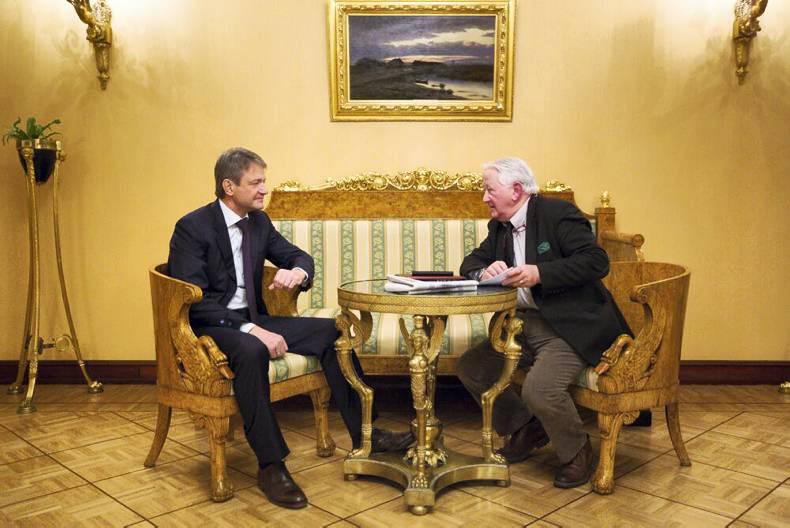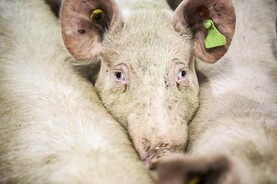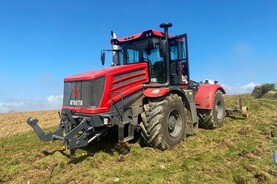Russia is taking a step into the past. The world’s largest country is attempting to become self-sufficient in agriculture. It has not been able to provide all foodstuffs for its people since the fall of the Soviet bloc.
Now, hastened by the ban on the importation of food from the EU, the United States, Canada, Australia and Norway, Russia has to feed itself once more. It was Russia’s decision alone to ban food from these countries, and it did so in response to sanctions placed on it following the annexation of Crimea.
Irish Farmers Journal contributor Brendan Dunleavy spoke with Russia’s agriculture minister in December. The country’s grain, poultry and pig sectors are growing rapidly but problems remain for its dairy sector.
Unlocking Russia’s potential
Brendan Dunleavy (BD): Russia is the biggest country in the world. Russia has potential to become the most productive agricultural country in the world. How and when are you planning to unlock this enormous potential?
Alexander Tkachev (AT): The basics of the Russian government’s policy governing the use of agricultural land resources up to 2020 stipulate introducing positive mechanisms to very substantially increase the area of agricultural land in production.
This progressive policy will very greatly stimulate the increased cultivation of all unused agricultural land in Russia.
Our objectives and the expected results of our policy are to immediately maximise Russian agricultural production. The ministry of agriculture of the Russian Federation also already implemented a range of other measures aimed at maximising the cultivation of unused agricultural land.
This policy is a key part of our national economic activities. For example, fines for not using agricultural land have recently been increased by 400%.
In addition, the Russian ministry of agriculture has developed draft regulations stipulating the improvement of the existing procedures to withdraw plots of land from the agricultural land registry if they are not inadequately cultivated.
Russian agricultural landowners who do not maximise the use of their land will also be subject to greatly increased taxation.
The ministry of agriculture is also simplifying procedures for transferring agricultural land currently owned by state and municipal authorities to private farmers, agricultural organisations and agribusiness companies.
Major global producer
BD: For the last 10 to 15 years, Russia has achieved strong results in production of wheat, barley, corn and other crops. As a result of this, Russia is now one of the major global producers and exporters of wheat.
How and when are you planning to implement the same standards and get the same results in livestock production?
AT: There have been many positive and progressive changes in livestock production in Russia in recent times.
The main stages of the effective modernisation of Russian livestock enterprises have been, No 1, the national project: the Development of Agribusiness, and, No 2, various state agricultural growth and modernisation programmes aimed at the development of agriculture, and regulating agricultural markets for raw materials and food products, etc.
As a result, modern pig and poultry farming are the two most dynamically developing livestock enterprises in Russia today. Over the last eight years, pork production in Russia has increased by more than 1.3m tonnes liveweight.
Pork production now accounts for around 30% of the overall national meat production in Russia.
Since 2008, 470 pig farms and large industrial-scale pig breeding and production complexes have been reconstructed and modernised.
All the best new pig breeding and production technology systems have been installed in these pig enterprises. As a result, the Russian pig population has increased by 3.2m head since 2008.
Poultry production has more than doubled in liveweight and now produces 5.6m tonnes per year. Poultry meat production in live-weight accounts for more than 43% in overall meat production.
Since 2008, about 500 large poultry agribusiness complexes and private farms have been brought into operation and reconstructed.
Strengths and weaknesses
BD: What do think are the strongest and weakest aspects of Russian agriculture and agribusiness?
AT: This year we have managed to stick to positive dynamics of agricultural production. As a result, we have 2% growth in this critical sector of the Russian economy. Specifically, agriculture is the only economic activity in Russia with stable growth, while all other sectors of the economy have stagnated.
This year has been especially good for Russian wheat production. The grain harvest is estimated at 102m tonnes net weight. This will enable us to meet the internal demand and we’ll be able export about 30m tonnes. According to our estimates, we’ve managed to harvest more wheat, more sugar beet, more vegetables and more buckwheat this year.
We’ve also harvested bumper crops of corn, soya beans, sunflower seeds and oil-seed flax.
Russian meat production increased this year by 5%, due mainly to increasing rates of growth in pig and poultry production.
We’re still having a challenging situation in dairy breeding and production. Despite the current production growth of 2% in large-scale agricultural enterprises, and 5% on private farms, private subsidiary farms have decreased production by 3%.
We need to take decisive action to additionally support dairy production. There should be diverse measures taken by the state, such as subsidies to attract investments and grants for dairy farmers. We also need to regulate the market in order to set adequate farmgate prices for food and farm produce.
We propose to increase the amount of grant aid from 20% to 35% of direct expenses for construction and modernisation of dairy farms. We will introduce state support for construction of specialised farms aimed at breeding, feeding and producing young dairy stock. These will be used to increase and restore the national dairy herd.
You know that Russia provides 100% of its domestic demand in grain, oil, sugar and potatoes, and more than 90% of its internal demand for poultry and pork. As for milk, the country produces only 81% of its domestic demand, and 75% of beef. We produce 33% of greenhouse vegetables and fruit of our domestic demand.
During the next five years, we’re going to focus our efforts on planting gardens and vineyards, launching new greenhouse and dairy complexes, increasing production in dairy farming.
The president of Russia Vladimir Putin has straightforwardly set the objective to fully meet internal demand with national food products by 2020.
Despite strict budgetary limits, the state prioritises the development of our agricultural sector and rural areas. In 2016, the amount of state support will be increased by up to 237bn rubles [€4bn].
Now we have an ambitious goal to feed our own people with local food. And this goal will be achieved within the next five to seven years.
Specifically, we are focusing on increasing pig and poultry breeding and production. Since the implementation of our national agricultural plan 10 years ago, we have managed to increase the level of self-sufficiency in poultry and pork from 60% to 95%.
We’ve also increased wheat production by 33%. In the mid-1980s, we imported 30 to 40m tonnes; now we’re exporting 30m tonnes.
Russia has enormous agricultural potential. It means that we need to make all efforts to attract investments to the food and agricultural sectors. It is high time now to invest and develop agricultural production. This a key to the future.
Moreover, we have all the components of success: investors, active farmers, markets, unlimited agricultural lands and copious fresh water resources. Furthermore, good prices for agricultural produce are now being achieved.
Today we’re witnessing qualitative change in the mindset of people in Russia. People have started to believe that we can feed ourselves. And this happened for the first time in many last year.
For Russia, import-substitution is not just a popular slogan – it’s a symbol of an important historical moment when we have advantageous opportunities for a major breakthrough.
Agriculture unites us all, and we need to do everything possible for the development and preservation of Russian villages.
Small farms
BD: For the last 55 years, the model of the family European farm (average size of 40ha to 50ha) has proved to be effective, highly productive, environmentally safe as well as socially and economically stable. For instance, Ireland is a good example of all these factors. Do you think this model could possibly be applied in Russia?
AT: Russian private farms are the most dynamically developing sector of our agricultural and rural economies. The share of private farmers in the total amount of gross agricultural product was 10% in 2014.
Russian private farmers contribute highly to crop production, which accounts for 15%. In 2014, they produced more than 25% of total crop harvest of grain and leguminous crops (26.4m tonnes), 33% of sunflower seeds (2.6m tonnes), and 10% of sugar beet (3.5m tonnes). The proportion of livestock products is 4.7%. This includes milk production (6.3%), plus grass-based meat and poultry meat production (3.4%).
All Russian state support-measures cover smallholders. I’d like to point out that we’re increasing the level of support for private farmers. Only this year, the level of support has been increased by over 55%, from 9bn rubles to 14bn rubles (€200m), using the “anti-crisis funds”.
As the result of these measures, 4,500 private farmers received grants. We’re having many grant proposals for the establishment of private farms and for development of family livestock farms. People have believed the state, and we should not fail them.
That is why next year 14bn rubles (€200m) will be invested by the ministry of agriculture to support private farmers.
Production goals
BD: What are your goals to increase production of milk, beef, pork, poultry, wheat and other agricultural products by 2020? What kind of financial support does the Russian government provide to Russian farmers and food processing enterprises that can ensure that set objectives are achieved by 2020?
AT: In accordance with the State Agricultural Modernisation and Development Programme 2013 to 2020, Russian milk production should be 38.2m tonnes in 2020. This will allow achieving 90% of target level of self-sufficiency with milk and dairy products.
According to our forecasts, grass-based meat production should be about 3m tonnes in liveweight by 2020.
By 2020, pig production will be 4.2m tonnes liveweight, and poultry production will reach 7.3m tonnes in liveweight.
Within the next five years, we’re going to construct 1,500ha of glasshouses for tomatoes, cucumbers and strawberries. We will plant 65,000ha of apple orchards. This will provide us with an additional 850,000 tonnes of tomatoes and cucumbers, and 1.3m tonnes of apples.
It means that we’ll double production of these agri/hort products and will completely replace imported products.
We’re going to plant 50,000 acres of new vineyards. In five years’ time, we’ll harvest an extra 220,000 tonnes of grapes. This accounts for growth of 50% of the current harvest and will decrease imports by 200%.
We will complete the historical mission to feed our own Russian people. We should ensure national food security with actions, not just in words.
Specifically, we will produce enough milk, meat, grains, protein and oilseed crops, vegetables and fruit to at least satisfy domestic consumption. We also have the capacity and the ambition to generate a large volume of exports of Russian food and agricultural production annually.






 This is a subscriber-only article
This is a subscriber-only article











SHARING OPTIONS: